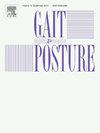Preoperative gait pattern as predictor of gait changes following selective dorsal rhizotomy
IF 2.2
3区 医学
Q3 NEUROSCIENCES
引用次数: 0
Abstract
Background
Selective dorsal rhizotomy (SDR) can improve gait in children with spastic paresis. However, outcomes vary, and selecting individuals who will benefit from the procedure remains challenging. How pre-SDR gait pattern predicts post-SDR gait has not previously been investigated.
Research question
This study aims to compare how different gait patterns change after SDR to gain insight into the potential relevance of gait patterns as a selection criterion for SDR.
Methods
Kinematic and kinetic data of nineteen children with bilateral spastic paresis due to cerebral palsy or hereditary spastic paraplegia, with 3D gait analysis before and two years after SDR, were extracted from an in-hospital database. A cluster analysis was performed to distinguish different gait patterns based on sagittal hip, knee and ankle angles pre-SDR. Deviations from typical gait per leg (38 legs) pre- and post-SDR were quantified with the Gait Profile Score (GPS), calculated for joint angles, moments, and powers. GPS was compared pre- and post-SDR per gait pattern, and pre-post differences were compared between gait patterns.
Results
Three distinct pre-SDR gait patterns (GPs) were identified using cluster analysis, with GP1 characterized by increased knee flexion (18 legs), GP2 by increased ankle plantarflexion (14 legs), and GP3 by increased knee flexion and increased ankle plantarflexion (6 legs). GPS-kinematics improved significantly for GP1 (-3.1°) and GP3 (-6.6°), but showed no significant change for GP2. GPS-kinematics improved significantly more in GP3 than in GP2. GPS-moments improved equally in all groups (-0.04Nm/kg--0.07Nm/kg). GPS-powers improved significantly more for GP1 and GP2 (0.07W/kg and 0.24W/kg, respectively) than for GP3 where no change occurred.
Significance
The results suggest that different pre-SDR gait patterns have distinct outcomes post-SDR in children with spastic paresis. Therefore gait patterns could guide selection and expectation management for SDR. Future studies should confirm these results in a larger cohort.
求助全文
约1分钟内获得全文
求助全文
来源期刊

Gait & posture
医学-神经科学
CiteScore
4.70
自引率
12.50%
发文量
616
审稿时长
6 months
期刊介绍:
Gait & Posture is a vehicle for the publication of up-to-date basic and clinical research on all aspects of locomotion and balance.
The topics covered include: Techniques for the measurement of gait and posture, and the standardization of results presentation; Studies of normal and pathological gait; Treatment of gait and postural abnormalities; Biomechanical and theoretical approaches to gait and posture; Mathematical models of joint and muscle mechanics; Neurological and musculoskeletal function in gait and posture; The evolution of upright posture and bipedal locomotion; Adaptations of carrying loads, walking on uneven surfaces, climbing stairs etc; spinal biomechanics only if they are directly related to gait and/or posture and are of general interest to our readers; The effect of aging and development on gait and posture; Psychological and cultural aspects of gait; Patient education.
 求助内容:
求助内容: 应助结果提醒方式:
应助结果提醒方式:


